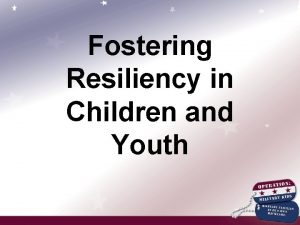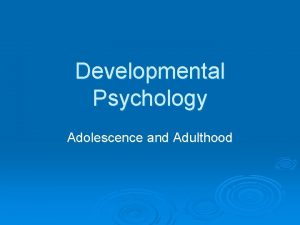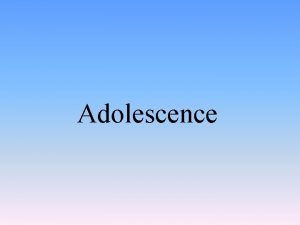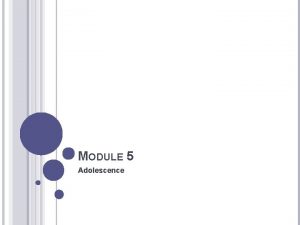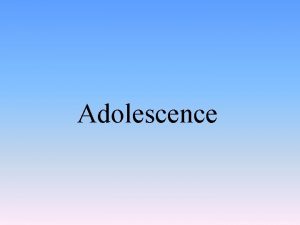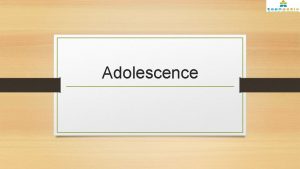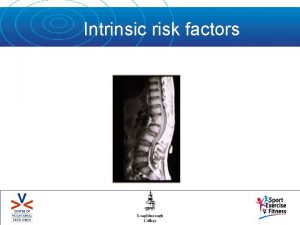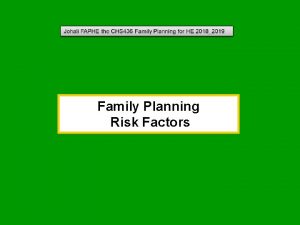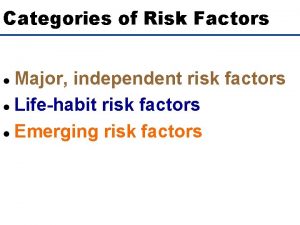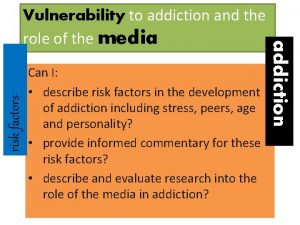Navigating Adolescence Risk and Protective Factors Navigating Adolescence




















- Slides: 20

Navigating Adolescence Risk and Protective Factors

Navigating Adolescence Typical Progression: navigate successfully the complexities of life develop fulfilling relationships adapt to change utilize appropriate coping mechanisms to achieve well-being without discrimination realize their potential have their needs met develop skills that help them navigate the different environments they inhabit

Navigating Adolescence Developmental Competencies & Resilience Developmental Competence: As youth grow and mature, they achieve mental and emotional milestones. This process can be described as the ability to navigate social, emotional, cognitive, and behavioral tasks at different developmental stages. A part of achieving developmental competence is adhering to cultural and social norms and developing a positive sense of identity, efficacy, and well-being. Resilience and Positive Youth Development: The Positive Youth Development movement, with its roots in prevention, has focused on the development of mental health through its focus on the role of resiliency, the protective factors in a youth’s environment, and the role they play in a youth’s ability to deal with adversity. Much like mental health promotion, the positive youth development approach promotes enhancing youth strengths and positive outcomes through fostering healthy relationships and providing opportunities.

Navigating Adolescence Prevalence of Mental Disorders 1 in every four to five youth in the general population meet criteria for a lifetime mental disorder that is associated with severe role impairment and/or distress. • 11. 2 percent with mood disorders • 8. 3 percent with anxiety disorders • 9. 6 percent with behavior disorders • An average of 17 percent of young people experience an emotional, mental, or behavioral disorder. Substance abuse or dependence was the most commonly diagnosed group for young people, followed by anxiety disorders, depressive disorders, and attention deficit hyperactivity disorder. • The rate of serious mental illness was higher for 18 to 25 year olds (7. 4 percent) in 2008 than for any other age group over 18. O • Onset for 50 percent of adult mental health disorders occurs by age 14, and for 75 percent of adults by age 24. 4

Navigating Adolescence Protective & Risk Factors As youth grow and reach their developmental competencies, there are contextual variables that promote or hinder the process. These are frequently referred to as protective and risk factors. The presence or absence and various combinations of protective and risk factors contribute to the mental health of youth. Protective factor: a characteristic at the biological, psychological, family, or community (including peers and culture) level that is associated with a lower likelihood of problem outcomes or that reduces the negative impact of a risk factor on problem outcomes. Risk factor: a characteristic at the biological, psychological, family, community, or cultural level that precedes and is associated with a higher likelihood of problem outcomes.

Navigating Adolescence Warning Signs for At-Risk Kids Marked fall in school performance Poor grades in school despite trying very hard Marked changes in sleeping and/or eating habits Severe worry or anxiety, as shown by regular refusal to go to school, go to sleep or take part in activities that are normal for the child's age Frequent physical complaints Extreme difficulties in concentrating that get in the way at school or at home Sexual acting out Depression shown by sustained, prolonged negative mood and attitude, often accompanied by poor appetite, difficulty sleeping or thoughts of death Severe mood swings Strong worries or anxieties that get in the way of daily life, such as at school or socializing Repeated use of alcohol and/or drugs

Navigating Adolescence Disordered Behaviors Mental Disorder: clinically significant behavioral or psychological syndrome or pattern that occurs in an individual and is associated with: • Present distress (e. g. , a painful symptom) • disability (i. e. , impairment in one or more important areas of functioning) • significantly increased risk of suffering death, pain, disability, or an important loss of freedom. • Mental disorders affecting youth include: anxiety, ADD, depression, bipolar disorder and suicide

Navigating Adolescence Effects of Mental Health Disorders IMPACT ON THE FAMILY Youth with mental health disorders pose challenges to parents and siblings. 1. Often singled out and blamed for family distress and disruption. 2. Family relationships often become strained because parents and caregivers do not know how to help their children or themselves. 3. The parental relationship is challenged, which may lead to marital discord. 4. The challenges may affect the family’s relationship with relatives as well as its social network which may isolate the family from potential sources of support. 5. Sometimes this cycle of difficult family interactions leads to social isolation.

Navigating Adolescence Effects of Mental Health Disorders IMPACT AT SCHOOL Some youth with mental health disorders have a difficult time succeeding in school. It is usually not because they do not want to succeed. Instead, behaviors, thoughts, and emotions related to their disorders interfere with their ability to do well. These same problems often lead to disciplinary actions in school even though the cause of the difficulty may be related to their mental health.

Navigating Adolescence Effects of Mental Health Disorders IMPACT AT SCHOOL Mental health disorders can impact all ages/stages of learning – elementary, middle and high school Likely to be unhappy at school Be absent Be suspended or expelled Learning is negatively impacted because of poor concentration, distractibility, inability to retain information, poor peer relationships, and aggressive behavior. May be withdrawn and difficult to engage

Navigating Adolescence Effects of Mental Health Disorders Up to 14 percent of youth with mental health disorders receive mostly Ds and Fs, compared to 7 percent for all children with disabilities. 3 Youth with untreated mental illness have high rates of absenteeism and tardiness. Of students with disabilities in the special education system, those with emotional disorders consistently have the lowest graduation rates and highest dropout rates compared to other disability categories. Only 32 percent of students with a serious mental illness continue onto postsecondary education

Navigating Adolescence Effects of Mental Health Disorders JUVENILE JUSTICE AND CHILD WELFARE SYSTEMS Fifty percent of youth in the child welfare system and sixty-seven percent of youth in the juvenile justice system have a diagnosable mental health disorder. Children and youth with mental health disorders in the child welfare system are: less likely to be placed in permanent homes more likely to be placed out-of-home to access services more likely to be placed in restrictive and/or costly services, such as juvenile detention or residential treatment more frequently treated in emergency rooms

Navigating Adolescence Promotion and Prevention Promotion: intervening to optimize positive mental health by addressing determinants of positive mental health before a specific mental health problem has been identified, with the ultimate goal of improving the positive mental health of the population. Prevention: intervening to minimize mental health problems by addressing determinants of mental health problems before a specific mental health problem has been identified in the individual, group, or population of focus with the ultimate goal of reducing the number of future mental health problems in the population.

Navigating Adolescence Promotion Early childhood interventions (e. g. , home visits for pregnant women, pre-school psychosocial activities) Provides support for children (e. g. , skills building programs, child and youth development programs) Programs targeted at vulnerable groups, including minorities, indigenous people, migrants, and people affected by conflicts and disasters (e. g. , psychosocial interventions after disasters) Incorporating mental health promotional activities in schools (e. g. , programs supporting ecological changes in schools and child-friendly schools) Violence prevention programs and community development programs that engage youth within their communities, schools, organizations, peer groups, and families in a manner that is productive and constructive, recognizes, utilizes, and enhances youths' strengths Promotes positive outcomes for young people by providing opportunities, fostering positive relationships, and furnishing the support needed to build on their leadership strengths.

Navigating Adolescence Prevention efforts can vary based on: 1. Audience they are addressing 2. Level of intensity they are providing 3. The development phase they target. As prevention efforts move from universal prevention interventions to treatment they increase in intensity and become more individualized.

Navigating Adolescence Levels of Intervention

Navigating Adolescence Preventive Interventions by Developmental Phase

Navigating Adolescence School-Based Support Schools provide a safe, nonstigmatizing, and supportive natural environment in which children, youth, and families have access to prevention, early intervention, and treatment. Adolescents are more comfortable accessing services through school-based clinics and like the idea of accessing a range of health and social services in a single location. Schools provide a natural setting in which students can receive needed supports and services and where families are comfortable and trusting in accessing these supports and services.

Navigating Adolescence School-Based Support Develop evidence-based programs to provide positive school climate and promote student skills in dealing with bullying and conflicts, solving problems, developing healthy peer relationships, engaging in activities to prevent suicide and substance use Develop early intervention services for students in need of additional supports such as skill groups to deal with grief, anger, anxiety, sadness Develop treatment programs and services that address the various mental health needs of students. Develop student and family supports and resources. Develop a school culture in which teachers and other student support staff are trained to recognize the early warning signs of mental health issues with students. Develop a referral process to ensure that all students have equal access to services and supports

Additional Resources http: //lemonlimeadventures. com/what-to-say-to-calm-an-anxious-child/
 Market risk credit risk operational risk
Market risk credit risk operational risk Aces protective factors
Aces protective factors Resiliency wheel
Resiliency wheel Navigating the body muscular system #1
Navigating the body muscular system #1 Digital landscape model
Digital landscape model Primatic compass
Primatic compass Bearings trigonometry
Bearings trigonometry Navigating gdpr compliance on aws
Navigating gdpr compliance on aws Navigating the art world
Navigating the art world Navigating gdpr compliance on aws
Navigating gdpr compliance on aws Residual risk and secondary risk pmp
Residual risk and secondary risk pmp Business risk vs financial risk capital structure
Business risk vs financial risk capital structure Attributable risk formula
Attributable risk formula Attributable risk (ar)
Attributable risk (ar) Common risk factors in the returns on stocks and bonds*
Common risk factors in the returns on stocks and bonds* Risk factors of head and neck cancer
Risk factors of head and neck cancer Abiotic factors example
Abiotic factors example Abiotic vs biotic factors
Abiotic vs biotic factors Abiotic factors and biotic factors
Abiotic factors and biotic factors Factors of 18
Factors of 18 Common factors of 10 and 20
Common factors of 10 and 20


